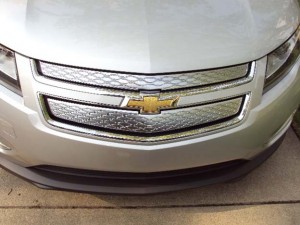
The nose of the current Chevrolet Volt, the first mass-market plug-in hybrid. It was redesigned for 2016. A pure electric Chevy Bolt could follow in 2017.
First came the Chevrolet Volt, now comes the Chevy Bolt. Even as General Motors gets ready to officially unveil an all-new version of its plug-in hybrid, various sources suggest the Detroit maker also will debut a concept version of a battery-electric vehicle at this week’s North American International Auto Show.
Significantly, the Chevrolet Bolt is expected to deliver as much as 200 miles range per charge. That would more than double what most of the current crop of electric vehicles can handle – and would be in line with what Tesla is thought to be targeting for the Model III, the mainstream EV it plans to launch in a couple years.
And, at an estimated $30,000, GM would likely undercut the smaller Tesla model while coming in only slightly higher than some competing vehicles delivering half Bolt’s range, such as the Nissan Leaf, the Ford Focus Electric, and the current Chevrolet Spark, which can travel just 82 miles per charge.
GM officials, including former CEO Dan Akerson, have been talking about hitting the 200-mile range mark for several years. While most motorists can get by with more limited offerings, studies show a large number of potential buyers don’t want to buy a vehicle that has the equivalent of barely a quarter tank of gas even when fully charged. Getting to something north of 150 miles would help reduce so-called “range anxiety,” according to many industry analysts.
(Chevy offers unexpected preview of redesigned, 2016 Volt. Click Here to check it out.)
Price is another critical issue that has limited demand for pure battery-electric vehicles, or BEVs. Most manufacturers have had to trim their prices to build sales. Ford recently made a second cut with the Focus Electric which now goes for about $10,000 less than its original MSRP.
For the industry, the good news is that as production has increased and engineers have learned more about working with battery technology they’ve been able to reduce size, mass – and price.
(Click Here for a quick guide to the most significant new products planned for the 2015 Detroit Auto Show.)
During a news conference last week, current GM CEO Mary Barra declined to say if the maker had met a goal of trimming $10,000 from the cost of building the Volt, but she did confirm that, “We’ve made substantial improvements” with the second-generation model that will be unveiled at the Detroit Auto Show on Monday.
The 2016 Chevy Volt is expected to deliver about 50 miles in electric mode, a roughly 50% increase over the first model, while substantially boosting fuel economy when its gas “range-extender” engine fires up.
At the time the original Volt went into development, lithium-ion batteries cost a carmaker as much as $1,000 per kilowatt hour. Today, industry sources say some suppliers are asking less than $400, and a target of under $200 may be in sight.
To achieve a 200-mile range would likely require as much as 50 kWh of batteries, so the savings compared to the original Volt batteries could measure in the thousands, perhaps tens of thousands, of dollars.
GM officials would not confirm plans to unveil a new battery-car at this week’s Detroit Auto Show. But they notably would not rule that possibility out. According to federal trademark records, GM applied to protect the name Chevrolet Bolt last August.
(Americans ready for autonomous vehicles – and willing to pay for them, says new study. Click Here for more.)
Top GM officials, including both CEOs Akerson and Barra, have strongly backed the maker’s push into electrification, the current CEO saying last week she was not going to back away from high-mileage technologies even as fuel prices plummet and sales of pickups and other fuel-hungry vehicles skyrocket.
But with sales of most plug-based vehicles, including Volt, in the doldrums, a new BEV could face troubles in the market. That is, of course, if the current slide in petroleum continues for more than a short while. That is a matter of much debate.
What’s clear is that GM has invested heavily in its electrification program – nearly $2 billion in Michigan alone, most recently upgrading an assembly plant in Detroit for the new 2016 Volt, while shifting production of key powertrain components to the state. Korean battery partner LG Chem, meanwhile, has a factory in Western Michigan.
Though still officially a “concept vehicle, the Chevrolet Bolt could reach showrooms by 2017, according to several sources. And they say GM plans to market the battery-car across the country, rather than just focusing on the California market, as some competitors have done with their own plug-based models.

Bad choice of car model names with “Bolt”. Volt = OK, Bolt = no good. They should have known better.
Fuel prices will go back up. Please publish the price factor of battery life and replacement cost with labor and taxes. Thx
The auto makers don’t want consumers to know the total cost of ownership for the EVs because the math simply does not work even with the subsidies and improper tax credits the states and Feds dole out that tax payers and non-EV consumers pay for. The car makers want people to buy these so the auto makers pay lower fines that will be passed on to non-EV consumers when the auto makers can’t meet the absurd, meritless 54.5 mpg decree of Obama and the EPA.
How about the Chevrolet Energizer or Chevrolet Duracell or Chevrolet Everready or Chevrolet never ready ☺☺
Is this going to be a CUV or Sedan ?